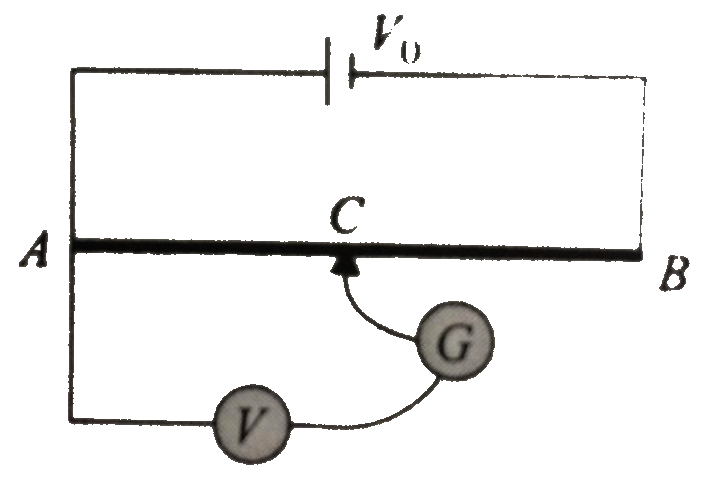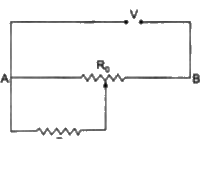A voltage V0 is applied to a potentiometer whose sliding constant is exacly in tne middle. A voltmeter V is connected between the sliding constant and one fixed end of the potentionmeter. If is assumed that the resistance of the voltmeter is not very high in comparison to the resistance of the potentiometer wire. What voltage will the voltmeter show : higher than, less than, or equal to V0/2?

Let R be the resistance of the whole potentimeter wire and RV be the resistance of the voltmeter. Then the total resistance across section AC is
RAC=RV(R/2)RV+(R/2)=R2(1+R/2RV)<R2
The resistance of section CB is equal to R/2. So the reading of the voltmeter will be less than V0/2.
Topper's Solved these Questions
- ELECTRICAL MEASURING INSTRUMENTSBOOK - CENGAGE PHYSICSCHAPTER - ELECTRICAL MEASURING INSTRUMENTSEXERCISE - Solved Examples
4 Videos
- ELECTRICAL MEASURING INSTRUMENTSBOOK - CENGAGE PHYSICSCHAPTER - ELECTRICAL MEASURING INSTRUMENTSEXERCISE - Exercise 6.1
15 Videos
- ELECTRIC POTENTIALBOOK - CENGAGE PHYSICSCHAPTER - ELECTRIC POTENTIALEXERCISE - DPP 3.5
14 Videos
- ELECTROMAGENTIC INDUCTIONBOOK - CENGAGE PHYSICSCHAPTER - ELECTROMAGENTIC INDUCTIONEXERCISE - QUESTION BANK
40 Videos
Similar Questions

A constant voltage V0 is applied to a potentiometer of resistance R connected to an ammeter. A constant resistor r is connected to the sliding contact of the potentiometer and the fixed end of the potentiometer. How will the reading of ammeter vary as the sliding contact is moved from one end of the potentiometer to the other ? The resistance of ammeter is assumed to be negligible.
View SolutionPotentiometer wire of length 1m is connected in series with 490Ω resistance and 2V battery. If 0.2mVcm is the potential gradient, then resistance of the potentiameter wire is approximately
View Solution
Knowledge Check
In the primary circuit of a potentiometer, a cell of E.M.F 1 V and a rheostat of 15Ω are connected in series. If the resistance of the potentiometer wire is 10Ω the minimum voltage at the ends of the wire (in V) will be
A0.1B0.4C0.06D1.0A battery of emf 26V and internal resistance 0.4 ohm is connected to a resistance of 10ohm and a potentiometer wire of length 10m. What is the potential gradient on the wire if the resistance of the potentiometer wire is 5 ohm –
A2.60V/mB0.250V/mC0.844V/mD0.422V/mPotentiometer wire of length 1m is connected in series with 490Ω resistance and 2V battery. If 0.2mVcm is the potential gradient, then resistance of the potentiameter wire is approximately
A4.9ΩB7.9ΩC5.9ΩD6.9Ω
A resistance of R draw current from a potentiometer. The potentiometer wire, AB, has total resistance of R0. A voltage V is supplied to the potentiometer. Derive an expression for the voltage across R when the sliding contact is in the middle of potentiometer wire.

View Solutionin the circuit shown in the figure, each battery is of 5 V and has an internal resistance of 0.2 Omega What is the reading of the ideal voltmeter V

View SolutionWhat resistance should be connected in series with a 0.5 A ammeter to convert it into a 15 V voltmeter ? Given that the resistance of ammeter.
View SolutionA potentiometer wire 10m long has a resistance of 40Ω. It is connected in series with a resistances box and a 2 v storage cell. If the potential gradient along the wire is 0.01Vm the resistance unplugged in the box is
View SolutionA voltmeter reads the potential difference across the terminals of an old battery as 1.40V, while a potentiometer reads its voltage to be 1.55V. The voltmeter resistance is 280Ω.
View Solution
